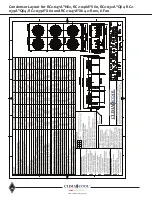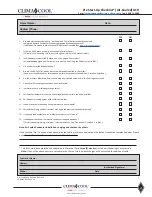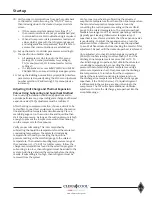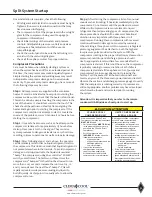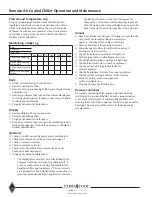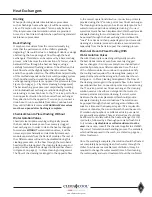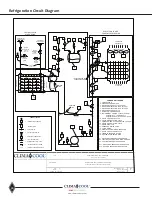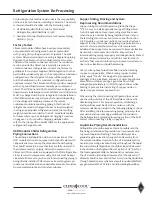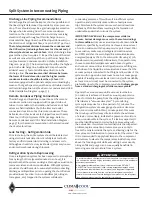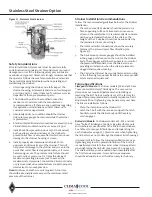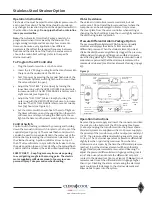
54
www.climacoolcorp.com
Pressure and Temperature Log
A log of temperatures and pressures should be taken
regularly . Periodically conduct a visual inspection of the
chiller to identify problems before they reach the point
of failure . As with any mechanical system, it is necessary
to conduct a series of checks to the ClimaCool chiller to
confirm correct operation.
Maintaining a Daily Log
Date
Chiller No.
Technician
Sun. Mon. Tue. Wed. Thur. Fri.
Sat.
Chiller Water Entering
Temperature
Chilled Water Leaving
Temperature
Chilled Water Pressure
Drop
Faults: Note by Module
Number
Daily
•
A daily operational log should be kept .
•
Perform visual inspection .
•
Record entering and leaving chiller water temperatures
and pressures .
•
Note any problems that may exist and immediately plan
for further investigation . If repair is necessary, schedule
for earliest possible date .
•
Properly document all data taken .
Weekly
•
Review daily log from previous week .
•
Perform visual inspection .
•
Properly document all data taken .
•
Note any problems that may exist . Immediately plan for
further investigation . If repair is necessary, schedule for
earliest possible date .
Quarterly
•
Check controller operating parameters and setpoints .
•
Check temperature drop/rise on heat exchanger . *
•
Check compressor oil level .
•
Check compressor oil color .
•
Check water flow rates and pressure drops across
evaporator heat exchanger .
•
Properly document all data taken .
* The temperature drop/rise on a fully loaded (both
compressors) heat exchanger is generally 10°F . If
only one compressor is running the temperature
drop/rise will be approximately 5°F . Some projects
are designed to have a higher temperature drop on
the evaporator depending on application . Consult
the bank performance sheet for the project for
these values . If the temperature drop/rise is greater
than the design, the heat exchanger may need to be
back flushed or the strainer may need to be cleaned.
Annual
•
Back flush all heat exchangers. If fouling is suspected use
only ClimaCool recommended de-scalers (see
page 54 - Chemical Clean In Place Washing) .
•
Remove and clean all waterside strainers .
•
Manually operate all waterside isolation valves, if
provided, on each module .
•
Check all electrical connections for tightness .
•
Perform leak check on all refrigerant circuits .
•
Check all header piping couplings for tightness .
•
Check oil level and color on each compressor .
•
Check and test all refrigerant safeties for
proper operation .
•
Check all peripheral systems for proper operation .
•
Check and test
CoolLogic
master control system .
•
Verify set points, sensors and general
control configuration.
•
Properly document all data taken .
Remote Condenser
Air cooled condensing units require a periodic cleaning
and this can be accomplished by a brush, vacuum cleaner,
or pressurized air stream of commercially available coil
cleaning foam . All of the condenser fan motors have sealed
bearings . The only acceptable service to these bearings
is replacement .
Remote Air Cooled Chiller Operation and Maintenance
Summary of Contents for CLIMACOOL UCR 30
Page 19: ...17 www climacoolcorp com Voltage Phase Monitor Wiring Diagram...
Page 29: ...27 www climacoolcorp com Evaporator Water Pressure Drop Charts...
Page 30: ...28 www climacoolcorp com Glycol Performance Adjustments Factor Charts...
Page 78: ...76 www climacoolcorp com Wiring Diagram...
Page 79: ...77 www climacoolcorp com Wiring Diagram...
Page 80: ...78 www climacoolcorp com Wiring Diagram CoolLogic Control Panel...
Page 81: ...79 www climacoolcorp com Wiring Diagram CoolLogic Control Panel...





